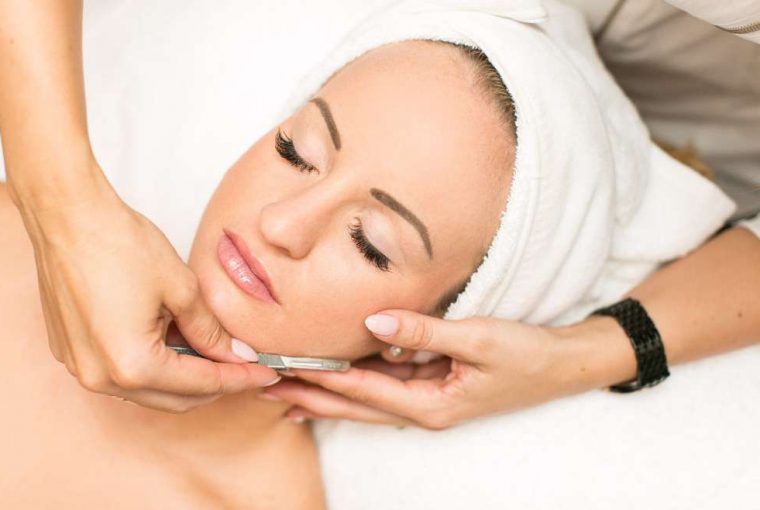You may have seen people on YouTube shaving their faces using small razors to exfoliate their skin or get rid of facial hair and wondered, “What is dermaplaning, and should I try it?”
While those YouTube tutorials may make dermaplaning look like an easy “do it yourself” procedure, experts say you should avoid trying this at home for several reasons that we will explain. Plus, dermaplaning is not recommended for all skin types, so it’s best to consult with a dermatologist about whether it’s right for you. Below, dermatologists explain what you should know about dermaplaning, including the risks, benefits, and cost.
What is dermaplaning?
Dermaplaning is a cosmetic procedure that involves scraping your face with a scalpel to remove the epidermis—your top layer of skin—and small hairs, explains Jenny Kim, M.D., Ph.D., professor of dermatology, medicine, and nutrition at the David Geffen School of Medicine at UCLA. Traditionally, people have the procedure done in a dermatologist’s office, however, you can find blades at the drugstore marketed for at-home dermaplaning use. That said, it’s safer for a professional to perform this. (We’ll get to all of that in a bit.) It’s also always a good idea to research any procedure you’re interested in, even if you delay the actual procedure itself because of the pandemic.
During a dermaplaning session, the dermatologist uses a medical-grade scalpel to scrape across the surface of the skin. The treatment takes about 15 minutes, and it can cost anywhere from $40 to more than $150, depending on where you go.
What are the benefits of dermaplaning?
The main reason people do it is to remove the vellus hairs on their faces, which some people refer to as peach fuzz. Everyone has these fine vellus hairs coating their bodies, and they serve a purpose: Vellus hairs keep us warm and add another layer of protection to the skin. But some people’s vellus hairs are thicker and more visible than others, and depending on how they feel about that, they might want to have it removed. Of course, dermaplaning is just one way to do that. There are many at-home hair removal kits that may get the job done, including the Glee Face Wax Hair Removal Strips for Women ($9, Walmart.com). However, dermatologist Rosemarie Ingleton, M.D., tells SELF that typical hair-removal methods like waxing and threading don’t always provide the results people are looking for, which makes dermaplaning an appealing option. You may have heard that shaving hair on your face makes hair grow back thicker—that’s technically not true. But it may look thicker or darker, thanks to having a blunter tip from shaving as it grows out, according to the Mayo Clinic.
People might try laser hair removal for longer-lasting results, according to Jeanine Downie, M.D., a dermatologist in New Jersey. This method damages the hair follicles using heat, so your strands don’t grow back as easily. Although it is marketed as a permanent option, your hair may grow back after any hormonal changes (like menopause), according to the Cleveland Clinic. It also takes several sessions to see changes. The exact amount varies, and generally, people with dark skin need more sessions compared to people with light skin. This option also doesn’t work on gray hairs.
Dr. Ingleton says that the biggest reason she does dermaplaning in her practice is to remove vellus hairs, but that the blade also gets rid of a superficial layer of dead skin. This can make your skin look brighter, help your skin-care products sink in better, and make your foundation go on smoother. In Dr. Ingleton’s practice, dermaplaning is often an add-on done before other treatments like microdermabrasion or ablative lasers like Fraxel. When it comes to exfoliating, there are no studies showing how dermaplaning compares to other treatments like retinoids or chemical peels, says Dr. Kim. That’s one reason why Dr. Downie prefers to use peels over dermaplaning—even for sensitive skin—and doesn’t offer dermaplaning in her practice. “Peels help to improve texture, tone, acne, and fine lines,” she says. “They are not equivalent at all, and many peels give deeper exfoliation than a scalpel,” Dr. Downie says.
Is it ok to try dermaplaning at home?
While it might feel like getting rid of these hairs is easy to do at home with an inexpensive blade, professionals warn against it. Any blade you get over-the-counter won’t be as sharp—or as effective—as the medical-grade scalpel used at the office. Also, there’s always the chance you will cut yourself in the process, potentially causing scarring.
Anytime a sharp object goes near your face, there is a risk of damage to the skin. Dr. Downie says that she’s seen patients with scarring after a dermaplaning session gone wrong. Although some medical spas offer dermaplaning, Dr. Downie recommends seeing a professional board-certified dermatologist for this kind of procedure. Board certification is an extra certification step that shows a physician completed advanced training in their specialty. (You can find a board-certified specialist by visiting The American Academy of Dermatology website.)
How often should you have dermaplaning done?
In order to keep the hair away, you might have to get treated about once a month. (Of course, the exact timeline will look different for each person.) Dr. Kim says this is not a treatment you should do too frequently. Our epidermis helps protect us from allergens and other potential irritants in the outside world—dermaplaning too often may irritate or damage that top layer of protection, she says. Again, this is why it’s best to consult with a physician who can help you decide on the appropriate frequency for your skin and needs.
When should you avoid dermaplaning?
There are a few instances where you should think twice before signing up for dermaplaning. If you have acne, there is a chance that the blade could nick a pimple, says Dr. Downie, which means it would take longer to heal. So if you have something like a serious cystic breakout happening, it might be best to postpone. Ideally, you want to consult with a doctor who has experience with acne-prone patients. Also, tell your dermatologist if you have a history of cold sores. “If you have a breakout of cold sores, you need to be on Valtrex, and the physician needs to avoid the area,” says Dr. Downie. Without the use of a preventive oral anti-herpes medication, the cold sores can spread due to microtears in the skin.
Is there anything else to know about dermaplaning?
After a dermaplaning treatment, you do need to take care of your skin. “You have to coat your skin with sunblock afterwards because you’re going to be more sensitive to the sun,” says Dr. Downie. “You also have to be cautious of retinol and glycolic acids.” Dermatologists recommend that people with sensitive skin use a light moisturizer like Vanicream ($36, Amazon) because it doesn’t contain fragrances or other irritants. If you do choose to try dermaplaning, just be sure to work with a professional dermatologist for the safest possible experience.




